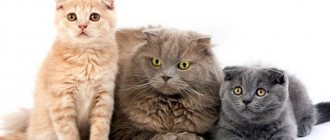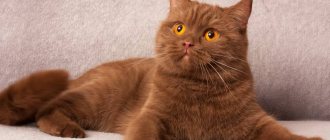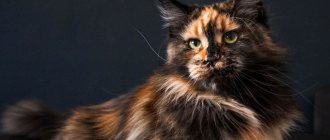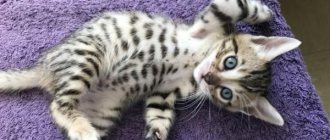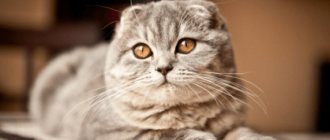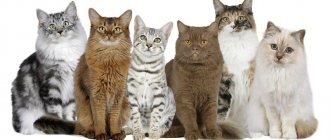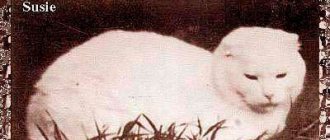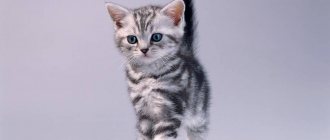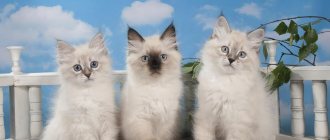Almost all lovers of such pets know the color of color point cats, thanks to the Siamese and Thai breeds. That is why it is quite often confused. But these are not all types of cats that have such an attractive color of their fur. In some distant countries this color may also be called Himalayan. Cats of these breeds are often affectionate and cannot be alone.
Plain (solid, solid)
The monochrome uniform coloring of Scottish cats is considered classic by breeders. The solid or solid color of the animal implies the absolute exclusion of any inclusions, small marks and specks of a different color. The tone is rich, even along the entire length of the coat.
The most common used to be considered blue plain Scots. But today among the representatives of the breed there are many other variants of solid colors.
White
A Scottish cat with snow-white fur (without yellowness) looks luxurious. Possible eye colors are blue, amber, copper. According to the standard, eyes of different colors are allowed. The paw pads and nose are light pink.
Kittens may have markings of a different shade, which disappear after the first coat change. By the age of two, the coat of a white Scot should be crystal clear, without spots of a different color.
Black
The black cat has expressive yellow eyes. The nose and paw pads practically blend into the main color of the animal.
On the shiny bright coat of the Scottish beauty Ebony, 2-3 hairs of contrasting white color are allowed. The presence of large red or brown marks is not provided for by the standard.
Important: Scottish Fold pets are endowed with magical abilities. It is believed that it is the black color of the Scottish Fold that protects the house and its inhabitants from evil spirits.
Chocolate
The brown Scottish cat, also called chocolate, looks noble and impressive. The color of the coat contrasts with the animal's yellow, golden or copper eyes. The nose and paw pads are also dark brown.
Lilac (lavender)
The monochromatic lilac Scottish Fold has a gentle gray tint that smoothly turns into cream. The nose is slightly brownish, the paws on the bottom are the same color as the coat, in harmony with the main color of the pet. This lilac-lavender color goes well with eyes of copper, amber or orange shades.
Red (red)
Red or ginger color is a rare and valuable color of the Scots breed. The fiery edge is combined with burning amber irises. Pads and nose to match the dominant color.
The tail of kittens and adult animals is not very evenly colored. This deficiency does not disappear with age and is allowed by the standard. And the presence of marks on the head and limbs that remain after reaching the age of two are considered a deviation from the norm.
A red Scottish straight-eared cat can give birth to kittens not only with erect ears, but also with ears pressed to the head.
Cream
The cream or peach fold cat is infinitely elegant and beautiful. The delicate background of light fur, bright golden eyes and a pinkish nose give the pet an irresistible appearance. The pads on the paws are also pink. An animal with this color is similar to a red Scotsman, but its coat color is a shade lighter.
A peach fold kitten may have a blurry, fuzzy pattern on its paws and tail that does not disappear with age. This is not critical for a purebred pet, but leopard markings are absolutely unacceptable.
Faun (deer)
There is another unique color of Scottish fold cats with an interesting name - fawn, which means “young deer”. The nose and pads on the paws of these beauties are beige-pink.
Cinnamon
Cinnamon is a lighter and more delicate color than chocolate, but darker than red. The nose and paw pads of such animals are brown, beige or pink.
Blue color (blue)
The gray or blue Scottish cat has very beautiful amber eyes. The coat tone of a purebred pet can belong to any range of gray - from the lightest (blue) to completely dark (blue). At the same time, each hair is saturated and well colored, without streaks.
The nose and pads practically do not differ in color from the plain coat.
A gray Scottish Straight cat may be marked with a few streaks and drawings in childhood. But as they grow older, these color flaws go away.
Main breeds
Thai and Siamese cat breeds are precisely those that have the color point pigment initially. This is implied by the standard. But there are other types. In addition to plain coats, they also have point subspecies. These include:
- Persian. This is the first breed that has been successfully turned into a pointing breed, with the exception of the Siamese. The Point Persian was created by mating a Siamese cat with an ordinary Persian cat. But there is also a small minus for the owners - a lot of attention must be paid to the luxurious fur of these pets.
- British colorpoint cats. This is a separate subspecies of ordinary Britons, which was first bred not so long ago. Breeding them is quite a difficult task, so babies of this breed are highly valued.
- Scottish straight. Representatives of this breed have darkened areas that look like a light haze. It was possible to breed by mating the best specimens of the British and Persians. These are very beautiful cats, and they also have a soft and flexible character.
- Neva Masquerade. These are Siberian cats with pigment coloring. They were first bred by St. Petersburg breeders by crossing Siberians and Siamese. The artificially bred breed is extremely beautiful. Its representatives have a rather large body with a very thick coat, which was inherited from their Siberian ancestors. It goes well with the colors of the Siamese, as well as the deep blue eyes.
- This coloring is found in all breeds of sphinxes, for example, Canadian or Peterbalds. They have point coloring on their skin, since the fur is completely or almost completely absent.
This is not the entire list of breeds with this coat color. There are also very rare ones, for example, snowshoe or Burmese. But they are not yet very common in the world.
Scottish Highland Straight
The Scottish Highland Straight is a subspecies of the Scottish cat. It is distinguished by the fact that it has long hair and erect ears. This variety has an unusual color. They brought her out in the 70s. years of the last century, when the British crossed with the Persians. Kittens from these breeds were able to get only the best. They have a very calm and friendly character, as well as a cute appearance. Highland Straights are easy to maintain. There is also a tortoiseshell variety, which also has a point color. Description of the breed:
- Quite long coat that is very easy to comb. Has a relatively dense undercoat.
- The ears are small in size with rounded tips and stand erect.
- The eyes are large and round in shape. Color may vary. He is completely dependent on wool.
- The body is strong, muscular, of medium size. Often these cats have a round shape.
- The toes are quite tightly clenched. The limbs themselves are long.
- The head is round and has a convex skull.
- Average tail length. He is very fluffy and active.
- These cats live from 10 to 20 years.
- The average weight of animals is 3.5 kg, and that of a cat is 5 kg.
- Standard length is 30 cm.
Two-color
A unique coat color is bicolor (two-color cats). The main background is snow-white. The second color in color (cream, black, blue, red) is presented in the form of unusual patterns. Thoroughbred representatives must have white belly, neck, chest, paws, muzzle and beard.
A prerequisite is the predominance of a white background in color. Bicolors are more valued; their body patterns are symmetrical. The eyes can be any shade, but are usually blue or golden yellow.
Cream bicolor
Cute white cats with additional streaks of delicate cream tones. The eyes are blue or yellow, and the nose and pads are pink.
Blue bicolor
The pattern on the wool is blue (delicate or rich gray). The iris of the eyes is a beautiful sky tone or yellow-orange. The nose and paws below are pink.
Black bicolor
Black and white bicolor is characterized by patterns of rich black tone. These cats have a pink nose and blue or copper eyes. A symmetrical, distinct pattern on the skin turns the cat into a real gentleman in a tailcoat.
Color point
Color-point is translated from English as “colored point”. The point coloring is explained by the presence of a gene, under the influence of which the coloring of hairs intensifies in some areas of the body with insufficient blood circulation. Characteristic darkening appears on the main white or cream background of the coat.
The second name of the color is Point Links. The eye color of cats of this color is necessarily blue. Previously, this coat color was observed only in the Siamese breed. But today it is present in other cat species, including Scots.
Newborn kittens are completely white. Only by the age of one month do babies begin to show color on their ears, paws, tail and face. According to this color, several subspecies are distinguished among the points.
Blue Point
This color is characterized by a pale gray-blue, almost white shade of the body with darker, gray markings. Soft gray Scottish blue point kittens have paws and noses that match the main color.
Cream point
The body is creamy white, and the shading on the animal’s face and tail are pastel cream colors. Paw pads and nose are pink. This point color goes harmoniously with the expressive blue eyes of the cat.
Lilac Point
The dominant tone is soft white or lilac, and the markings are gray with a pink tint. The nose and paws are the same as the main color.
Seal Point
The darkest color among the points. The dominant tone is beige. Contrasting with it are brown and black markings. The same dark nose button and paw pads.
Chalklit Point
Chocolate or choclit point is distinguished by a brown pattern on a cream background. Paw pads and nose range from light cocoa to darker brown.
Red point
The main coat color is pale apricot, almost white. Darkening on certain parts of the body is red-red in color. The pads and tip of the nose are bright pink.
Color Description
If translated from English, “color” means color, and “point” means a point. Points are small dark spots located on the face, tail, paws and ears.
The usual color of a cat is solid. The pigment is evenly distributed throughout the animal’s fur and body. Therefore, you can see the uniform color of the pet.
For a color point cat, everything is completely different. Their DNA contains the cs gene, thanks to which the pigment enters only the peripheral parts of the body, that is, the cold ones. They are located at a relative distance from the warm ones. Such areas are the ears, tail, paws and muzzle.
In other parts of the body, where the temperature is relatively higher, the pigment is not able to manifest itself actively. Scientifically this is called acromelanism .
As a result, the pet’s body is painted a lighter color than the rest of the body. The overall color tone remains uniform, but only changes in its saturation and intensity. The more pronounced the border between light and dark coats is, the higher the value of such a cat for exhibition work.
Dark pigmentation can be more than just brown. There are also these colors:
Based on this, individual varieties are distinguished, for example, seal point, red point, blue point, etc. Certain breeds can combine several shades at once.
Tortoiseshells (torties)
The tortoiseshell color of Scottish Folds is usually tri-colored. Red, white, and black spots are located on a cream or red dominant background. When the genes of the parents are combined in a tortoiseshell kitten, these markings can take on chocolate, blue and cream shades.
When assessing tortoiseshell cats, felinologists pay attention to the even distribution of markings and the intensity of their tone. Fold-eared and straight-eared Scots with a tortoiseshell color are divided into subspecies (depending on the color scheme of the spots).
Black-red
There are black and red-red patterns all over the cat's body. The sizes and shapes of the spots are very diverse. This color is often called tortie.
Chocolate red
The patterns on the wool are brown and red. They stand out against a lighter background and look very interesting. The chocolate red color is considered rare and prized by breeders.
Blue-cream
The tortoiseshell blue-cream color in Scottish pets is determined when the main gray-blue background is covered here and there with small light cream spots.
Important: tortoiseshell coloring is characteristic only of cats. The calico cat is very rare. The appearance of a male tortoiseshell kitten indicates genetic problems. Most likely, an adult pet will not be able to have offspring, since the reproductive functions of its body are impaired.
Features of character and behavior
By taking a Scottish Straight into your home, you will forever forget that a cat can tear up wallpaper, ruin furniture, or rip a curtain off a curtain rod. Scottish Straight plays pranks, but on a very limited scale; after such a game, one would not dare to say that a hurricane swept through the house. Everything is orderly, peaceful, noble. The innate intelligence and delicacy of a cat does not allow it to play mischief, so it is difficult to see the cat on the table in search of tidbits. He will just wait for you to treat him yourself.
This is not to say that adult cats or kittens are hyperactive animals. They don't exercise much, so they may suffer from overeating. If you see that your cat has become even more rounded, it’s time to go on a diet or start actively walking. Innate curiosity makes this cat an attentive observer and even a hunter. Cats living in a private home can hunt successfully, bringing their prey to the owner for display.
This cat's patience is truly limitless and extends to all households, including noisy small dogs. Scottish Straight never makes a scandal, he just goes away and hides in a hard-to-reach place. And it’s unlikely that you’ll get him out of there until he wants to get out. These cats rarely speak, preferring other methods of attracting attention.
Scottish Straight loves all family members equally, not depriving anyone of attention. He has favorites, but the cat will not demonstrate this
She also does not need too close contact with her owner; the cat prefers to sleep next to her, and not on her lap or hands. The Scottish Straight is a very caring cat, and often makes the rounds of all family members in turn. From the outside, it looks like a visit from a caring family doctor: the Scottish straight-eared cat will definitely sniff you, touch you, let you pet him, and, making sure that everything is okay with you, will move on.
Kittens can be a little willful in nature, but they train well, easily accept the rules of the game and are able to get used to the tray and unpleasant grooming or bathing procedures in a short time.
Mutual respect, love and understanding will reign in your home with a Scottish Straight cat. You will listen with surprise and an incredulous smile to the reviews of colleagues and acquaintances about mischievous or harmful pets, remembering your ideal cat.
Smoky (smoky, tuxedo)
The color of Scottish Fold cats can be smoky. On top the coat is one color, for example black. And at the base, each hair is silvery-white. This coloring is characteristic of cats with a dominant silver gene, which creates unusual combinations of light and dark shades.
Smoky color is easy to confuse with solid color. To avoid mistakes, you just need to look at the undercoat. With a smoky color, the undercoat of a different shade is clearly visible, and with a solid color, the color of the roots does not differ from the tips.
The eyes of smoke cats are usually yellow-gold in color. Based on the shades of smoke on the fur, several subspecies of this color of animal are distinguished.
Blue smoke
Smoky blue Scottish Straights and Scottish Folds are distinguished by the color of their fur coat with a gray cold coating. But underneath the fur is white and silvery. The paw pads and nose of these pets are gray-blue.
Black smoke
This color in Scottish cats is characterized by a black edge, but the hair at the roots is white. The nose mirror and pads do not differ from the main background.
Chocolate smoke
The snow-white undercoat is combined with a brown-chocolate topcoat. The nose button and paw pads of these animals are brown in color.
Smoky Scottish Straights and Scottish Folds, despite their unique color, cannot participate in exhibitions. Such cats are not recognized by the breed standard.
Features of color
The color point cat breed is no longer some kind of exotic. Every year such pets are becoming increasingly popular. But they still have certain features:
- Color point kittens are always born only in light shades. Only after a few days do the first pigment spots begin to appear on the paws, tail, and then on the face. This is due to the fact that during intrauterine development the kittens were exposed to constant warm temperatures. After birth and exposure to a colder environment, the coloring pigment begins to activate, which entails darkening of certain areas of the body.
- The appearance of a point kitten can only be guaranteed if both of its parents also have a pigmented color. But sometimes there are exceptions. One or even both parents can have a solid coat, but be carriers of the cs gene, which is responsible for darkening the peripheral areas of the body. In this case, some kittens will turn out to be pointing.
- The intensity of the color difference depends on the temperature in which the animal is located. The lower it is, the darker and richer the pigment areas will be.
- The cs gene is directly related to the color of the pet's eyes, which must be blue. In this case, the breed does not matter. The brighter and more saturated the color, the better the color of the animal appears.
It must be remembered that cats kept in cool conditions may completely lose their unique color. The ideal temperature for such breeds is from +25 degrees Celsius.
Tabby colors
Scottish tabby cats are very popular among breed lovers. This color suggests the presence of patterns on the pet’s fur.
Depending on their shape and size, tabbies are divided into three types:
- Striped (tiger) color - the presence of clearly defined vertical stripes.
- Spotted (leopard) - the pattern is made up of spots on the animal's fur.
- Marble color is a pattern of larger chaotic marks of different shapes.
A prerequisite for tabby cats is the presence of the letter “M” on the top of the animal’s forehead. The color combinations of wool are surprising in their diversity:
- cream;
- golden;
- blue;
- marble on silver;
- black marble;
- silver;
- silver-blue.
Important: Scottish tabbies with a silver tabby color resemble the mustachioed pet from a cat food commercial. Many believe that it is the Scottish straight-eared cat with a tabby pattern that appears on the screen. This color is also called the whiskey color of Scottish cats.
Maintenance and care
Almost all breeds with this color are more valuable when the contrast between the base color and the pigment parts is strong. Therefore, the main task of a person is to maintain the correct color. In addition to temperature, other factors also affect color.
The first one is age. Almost every cat darkens over time . The pet’s diet can also greatly affect the color. An indisputable fact is that carrots and seaweed, which contain a lot of iodine, can change the color of an animal. You should be careful about the composition of the feed. It is not advisable to give your cat vitamins that contain seaweed and kelp. You should not feed foods containing a lot of copper.
Experts have noticed that Thais begin to quickly turn dark when eating beef, any seafood, liver and buckwheat. If there is a predisposition, then the best solution would be to use special feed.
Any damage can also change the color of fur and even skin. In areas where injury or surgery has been performed, the fur will be much darker. This is due to the fact that that area of the body will become much colder. In some cases, color may return after the first molt, but this does not always happen.
If you definitely need to have surgery, then it is advisable to choose a place that will be least noticeable. After the procedure, it is necessary to carefully wrap the incision until complete healing.
We must not forget about trimming the claws. This should be done so that the pet cannot hurt itself.
Chinchilla
The Scottish chinchilla borrowed the extravagant colors of its coat from the British, and they, in turn, from Persian cats. A chinchilla kitten is born only from parents with an unusual color. Each hair is colored in two colors.
Most of it is light in color and 1/8 of it (the top) is dark in color. This phenomenon is called tipping.
Tipped chinchilla colors can be of 3 types:
- Golden. The cat has a white undercoat. But on top there is a reddish coating over almost the entire surface of the body (on the sides, back and tail of the animal). Only the beard, the tips of the ears and the belly are white. Yellow-gold eyes, pink pads and a brick-colored nose.
- Silver. White wool coated with silver gives an interesting gray effect. The color of the tail has a hint of stripes, the nose is beige, and the eyes are green. Snow-white tips of the pet's ears, chin and belly.
- Blue golden. The rarest and therefore valuable color of Scottish chinchillas. The undercoat is a delicate caramel color, and the tips of the hair are a radiant blue hue. The eyes are natural emeralds of a rich green tone.
Shaded (shedded) colors
An unusual definition refers to the interesting color of Scottish cats - shaded colors. These pets have almost white fur, but the tip of the guard hair is colored.
The top layer of a cat's coat can be any shade typical of Scottish cats. The undercoat is white. The sides, back, head, tail and ears are shaded. Light belly, chin and lower tail. There should be no obvious spots. The “M” sign on the forehead and darkish rings on the paws are acceptable.
Shedded colors can be of three varieties:
- Golden. The fur of the Scottish cat is golden, the undercoat is cream or light peach. Green eyes are very expressive and beautiful. The nose button and paw pads are chocolate.
- Red. This type of shaded color has a dark red coating on the coat with a snow-white undercoat. The eyes are amber, the pads and nose are pink.
- Silver. The white undercoat combined with the dark gray topcoat produces an amazing gray tint. Greenish eyes are lined with black stripes. This feature is typical only for the silver shedded color. Other varieties have eyes without a contour. The nose is brick-colored and the mouth is dark-lined.
